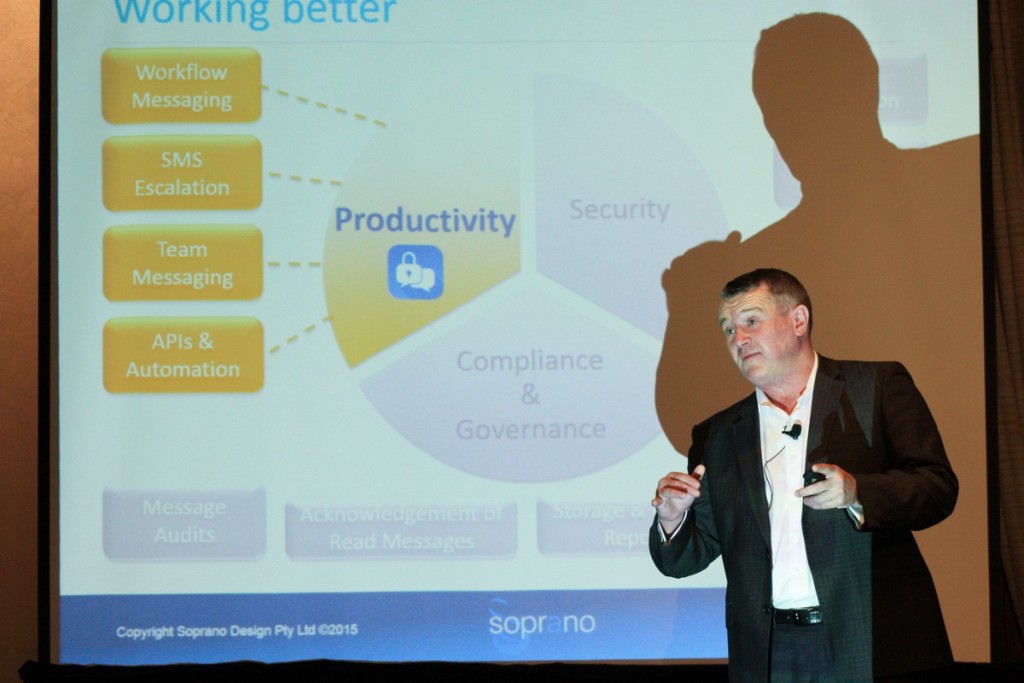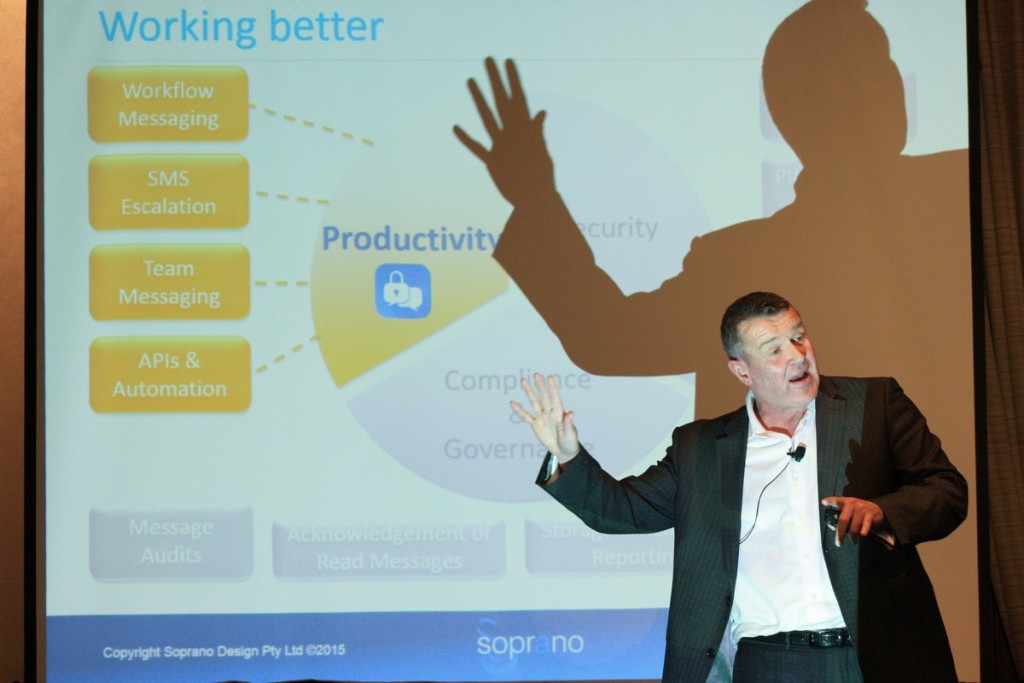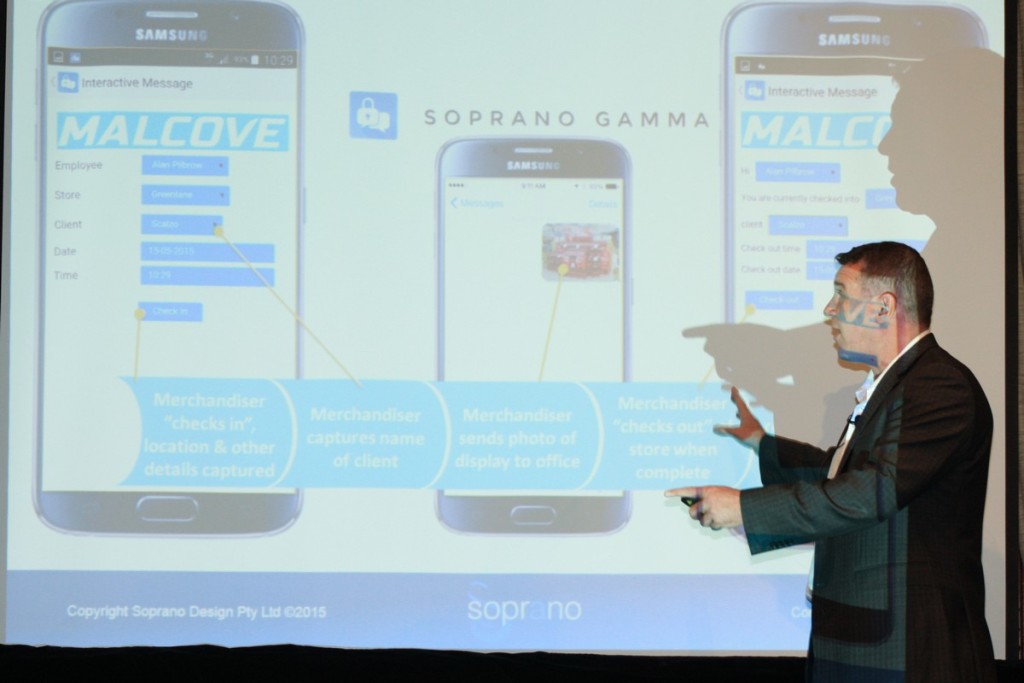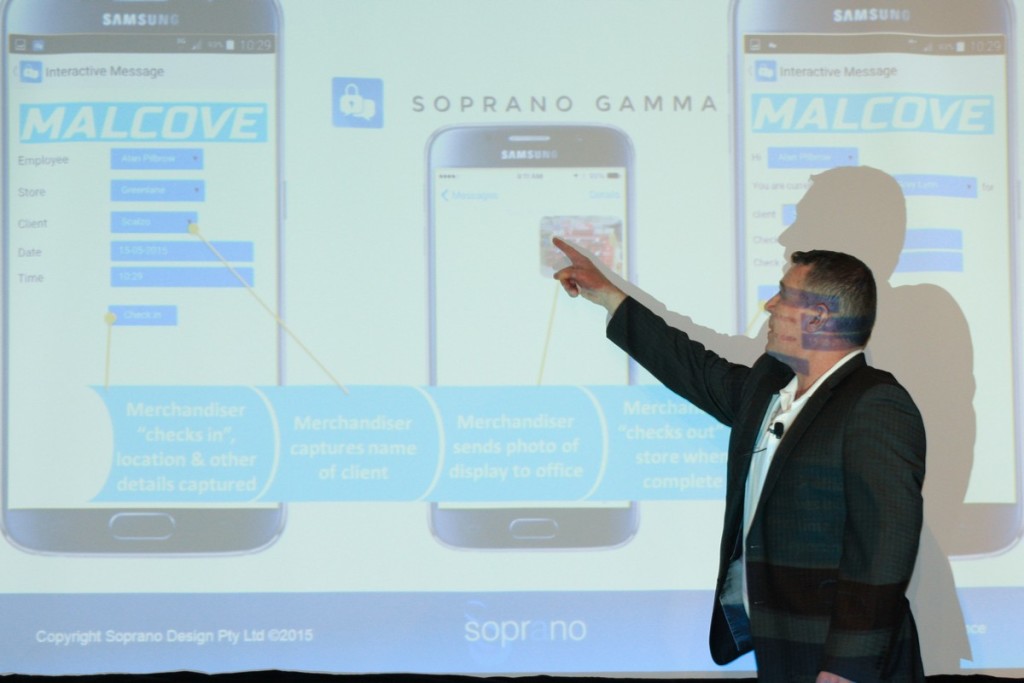A growing trend away from consumer apps to secure messaging apps is about to get a significant global boost as some of the world’s biggest software companies embed mobile payment platforms in their messaging applications.
Identity theft and hacking until now have been the main drivers for the enterprise and government sectors to move to secure messaging. But that is rapidly changing. And everyday transaction payment capabilities in secure messaging apps will be a key driver with the ubiquitous spread of the “app culture”.
Soprano Design, a world leader in developing secure messaging technology, told the OTT Summit in Sydney the introduction of payment apps in everyday business by banks and credit card companies is going to accelerate the introduction by the mobile messaging giants.
“In the history of mankind, the strategic landscape has not changed as quickly as it is at the moment and in this messaging space it’s certainly accelerating,” the company representative said.
“As one of China’s biggest online companies, TenCent’s WeChat, moves successfully into the mobile market, acquiring hundreds of millions of users, they’ve already introduced payment capabilities into the mobile apps.”
He said the simple daily activities like paying for a coffee will be transacted using an app.
“I click the icon of the coffee shop as I would if I wanted to be friends with you, if we’re just going to chat, and I can then pay for my coffee in the actual messaging app,” he explained.
“They only launched it last year and they’ve got 200 million credit cards. Of 600 million, one-third have now put out their credit card, linked it to their messaging application and are using that to conduct transactions.”
Soprano Design told the OTT audience he believes companies like Facebook will be quick to follow with secure transaction payment capabilities.
“When I go into Facebook Messenger, I’m accessing an app store. So I don’t have to go into the iPhone or the Android app store to get my app to plug it in the Messenger, I’m accessing the app from within Facebook Messenger and the same thing is happening here,” he said.
“Probably Apple is the only one that has more credit card details on record. These guys have got 200 million on that growth rate in terms of credit cards. So you wonder who’s going to win that whole payments debate. It could end up being a messaging platform.”
Soprano Design said the future potential was evident with the release of Facebook Messenger earlier this year: “The thing about Facebook Messenger, which is better than sending a text message, is I can send an image, I can send my location, I can send a voice message, all this great stuff. Next time you’re on the app, press this button here, which is ‘more’, like an attachment and when you do that, guess what? You will get the ability to embed a suite of applications within Facebook Messenger.”
Ready to find out more? Take a closer look at Soprano GAMMA.
Full transcript of Soprano Design’s secure messaging presentation at the Australian OTT Summit
“For the audience, this is a slight shift. The conference is titled OTT, but a lot of the discussion has been about video. We are going to switch tack here and focus more around the messaging space, but I think it’s interesting when we go through the trends and see how the industry is changing. I think there’s some fascinating parallels about the way disruptive technologies make a difference in different market segments.
“So if I were to show you a graph that says consumer text messaging is on the decline, this wouldn’t surprise anyone. I think it was about three years ago that the [numbers of] text messages we were all sending on Christmas Eve actually dropped because people were starting to send those messages through these different channels.
“If you look at the slide — so this is the person-to-person messaging, this is the global market and you see there in US dollars, it’s $80-$100 billion, is the value of the global market of text messaging and it’s been coming down for the last couple of years. This actually hides the extent to which it’s been coming down in western markets because these are the global numbers.
“If you look at when the growth started to slow, it was actually 2010, and that was the year, of course, that WhatsApp was launched. Particularly in the western markets, we have this sense that it really is all about WhatsApp and it is about Facebook Messenger, but when you look at the global growth in mobile messaging applications around the world, you do have WhatsApp — that’s the top line there, WhatsApp; this is Facebook Messenger; here, increasing; WeChat and Snapchat are in the mix here; and this is up to the first quarter of this year in terms of calendar years.
“A couple of interesting things to note. The growth rate of WhatsApp is four times what Facebook was. So if you go back to when WhatsApp was launched and you roll forward four years, they had three times the number of subscribers as Facebook after four years and five times as many subscribers as Twitter. So no applications in the history of the world have grown as fast as these applications have grown globally.
“Another fascinating point to note is, like I say, we have this western view of what’s going on, but when you look across different Asian regions, in particular WeChat in China is the number one messaging application there. We’ll talk about Wēixìn, which is actually the indigenous version of WeChat, it’s all owned by Tencent.
“You look at Line being the number one provider in Japan. Interesting for those of you that understand the technology players in Asia, but actually it’s a Korean company, so a Korean company being the number one messaging player in Japan and they were beaten in Korea by Kakao and Kik – little known Kik is the predominant player in Canada. So it’s actually fascinating, it’s not just WeChat and Facebook Messenger, but we’ll come back and talk a bit about the value of owning this space, it’s very important and there is a battle going on.
“Another fascinating point to note is that generally the trend is moving towards people using more than one messaging app. So there are the stats out of the US — this is a very US-centric view — the important thing to note is that if you add up the percentage share of each of these, for the average number of messaging apps, members of the US population are using two, on average. That means a lot of people are using more than two, and I think it’s fascinating.
“And for those of you that have got kids at that right age, you would have seen them using Snapchat and I must admit, when my kids were on Snapchat when they were 14 and 15, I was convinced it was a fad. Here they are, they’re both at university now studying but they’re still using Snapchat, and it’s fascinating.
“They’ll use Facebook Messenger, they’ll use the other messaging types, but they’re using Snapchat and I think it’s a useful insight because they differentiate these messaging channels clearly. When they post something on Instagram, when they send anything on Facebook, my daughter used the term “I’m curating the content” because it’s there forever, so I’m managing my image out to the world. Snapchat is real because I send it, because I’m having a good time and it disappears. So it’s fascinating the way that people are using these applications in different ways. So it’s not just that single app.
“And as we talked about, the market for the carriers for the SMS business has already lost $20-$30 billion globally and they’re going to continue to lose money, and they’ve tried a couple of different strategies around the world to compensate and I think there’s a couple of very interesting points about this. Every plan you buy today — it’s not just here, anywhere in the world — you buy a carrier bundle and essentially text messages are free, it doesn’t matter whether it’s Vodafone, Telstra, etc.
“So essentially what’s happened is text messaging went from — remember we used to pay 25 cents for a text message? — 25 cents to free. But even though it’s free, today I paid $1 a year for WhatsApp, even though it’s free I’m not using it because the consumer messaging applications provide a tonne more capability than I can do with just boring plain old SMS.
“The carriers tried other strategies. They basically said ‘Right, we need our version of WhatsApp’ and in fact it’s the European markets back in 2012 where for the first time some of the carriers went out publically and said ‘Look, we’re in trouble here, we’ve got to make some changes’ and the big carriers in Europe launched these products, and it’s fair to say that they weren’t successful.
“So if you look at the Telefonica 2Me application, they basically canned that after two years of pushing it very hard. For LiveOn, they did a pivot; these guys launched another product, an application to put on your devices that would allow you to access services through your SIM card through your billing account, but they failed. They thought ‘We can do this, we’ve got these great big marketing budgets, we can be successful’ and they weren’t.
“Mobistar’s actually gone back to the market, done a deal with Line — which was the Japanese messaging provider — and has launched Line in that market because they couldn’t beat it. So they tried to do their own thing, it didn’t work and now it’s with a partner. I think, Reg, you were making the point, the carriers need to look at ways that they can partner with these guys that are more innovative.
“And I think that talks to a couple of important issues about the way industries change, about the way technology shifts. It means there are certain types of businesses that just aren’t built to react to that rapidly changing strategic environment, and we’re all living in it.
“In the history of mankind, the strategic landscape has not changed as quickly as it is at the moment, and in this messaging space it’s accelerating. So what we have to do is look at some of the key trends in the space with a view to looking at what that means, because I think we won’t be seeing the ramifications for another 2-3 years.
“The first one is Facebook Messenger. How many people have actually got Facebook Messenger and use it on their phone? Probably half the people in the audience have got it. The thing about Facebook Messenger, which is better than sending a text message, is that I can send an image, I can send my location, I can send a voice message, all this great stuff.
“Next time you’re on the app, press this button here, which is ‘more’, like an attachment and when you do that, guess what? You will get the ability to embed a suite of applications within Facebook Messenger. So in the old days it was just sending messaging as a service. So this is an animated GIF, now when I go and I click that, I select ‘install GIFEE,’ I install GIFEE into Facebook Messenger and suddenly I’m accessing applications within a messaging application.
“Now I think this is a profound change in terms of the way messaging is changing the world. Without Facebook Messenger, you still would be part of the same app; instead, they’ve split it out. Why have they done that? Because they see the power of messaging as a platform in its own right. So we’re talking about consumer trends here.
“Let’s switch our focus now to the other side of the world. So this is WeChat — Wēixìn if you’re in China — this is the application that you would download. They don’t split out their numbers and as we saw earlier, there’s 600 million subscribers, not growing as fast as Facebook Messenger. I should also point out that Tencent in China also owns QQ. So QQ is like the old MSN Messenger or Yahoo! Messenger and has made a successful transition in the Chinese market into mobile, and the two of them are about the same size. So 1.2 billion subscribers on either WeChat, Wēixìn or the QQ messaging application.
“So this was just a messaging application for sending emoticons, and now what they’ve launched is mobile payments within the messaging app. So in the same way that you’ve got your app on your phone and you see a person and you want to chat with them, I’m in the coffee shop, I search for them, I click the icon of the coffee shop as I would if I wanted to be friends with you if we’re just going to chat, and I can then pay for my coffee in the actual messaging app. So the messaging app is morphing into a mobile payments platform, which is fascinating.
“They only launched it last year and they’ve got 200 million credit cards. Of 600 million, one-third have now got out their credit card, linked it to their messaging application and are using that to conduct transactions.
“But when I go into Facebook Messenger, I’m accessing an app store. So I don’t have to go into the iPhone or the Android app store to get my app to plug it into the Messenger; I’m accessing the app from within Facebook Messenger and the same thing is happening here. Probably Apple is the only one that has more credit card details on record. These guys [Facebook] have got 200 million on that growth rate in terms of credit cards. So you wonder who’s going to win that whole payments debate, it could end up being a messaging platform. It’s a fascinating trend.
“The final important trend that I wanted to talk to you about is actually secure messaging, and there’s a whole bunch of secure messaging. In fact, we have a secure messaging platform that we’ve launched.
“Now I wanted to point out that Telegram — [In the context of the recent Paris attacks], a BBC report talks about the number of the bad guys that are getting onto Telegram, a free secure messaging application.
“Originally it was just like a secure version of WhatsApp. On 26 September, they essentially integrated Twitter — the whole concept of following people — and they had 4,500 followers in the space of a week. So what does that mean?
“We talked before about how hard it is for carriers to respond to what’s going out in the market and governments are even slower. So there are lots of challenges there in terms of the technology and all of this speaks to that rapid change. It’s moving, moving very fast. And you could argue some of this stuff is starting to play in the business space as well.
“We’re going to change tack now and have a look at what that means for the enterprise space? What does that mean for businesses when we’re starting to talk about messaging?
“That same graph I had before that showed that consumer SMS is on the decline — Portico’s predicting decline next year — the number of messages being sent by businesses, either to their own staff or to customers or to their suppliers, will exceed the number of text messages that people are sending to each other. I challenge you next time you open your phone — maybe we’re too old, we’re the wrong demographic — but if we look at the younger demographic and you look at the messages you’re getting here, banking, one time passwords, you’re getting your notifications from the NRMA [Australian insurance company]. That stuff is on the increase and this is our core business, this is where we started out, and I’ll talk about what that means for a company like us when it comes to things like cannibalisation.
“All of you have probably received a text message delivered by our software. If you bank with three of the top four [Australian] banks and you get a bank one-time password delivered to your phone, that’s our software that delivers that. And the bank is paying Telstra, in this case, and then us to deliver that text message.
“I can say in the last three years our volumes have gone up tenfold. This year we’ve had between 1 to 2 billion messages so far and every one of those messages is important. It may be a one-time password, your flight is running late — it’s mission-critical stuff. I think the fragmentation of mobile communications is actually lending itself to this because 10 years ago, we were using clunky Yahoo! Messenger and MSN. These days there are just so many ways that I can get the messages to someone’s phone, but the only way that you will guarantee that you will get a message is via text messaging.
“We’re a leader in this space, but we are under no illusions that this market eventually is going to change and there’s different market dynamics; it won’t change as quickly, but it’s going to change, because you’ve got a device in your pocket that’s got more computing power than they had to put a man on the moon and yet we’re still using just text messages for businesses.
“And there are big differences. Our view is that there are big differences between consumer messaging apps and business messaging apps. The key ones from our perspective are productivity, collaboration and security between clients and government.
“We did a workshop with a bunch of CIOs at the CIO leadership summit about six months ago and we probably had all the CIOs in the room — I think more than half were ASX Top 100 companies — and I asked them, ‘Is security really important in messaging?’ Only 50% of people put up their hand. That surprised me, and it’s because [they think of it as] only texting “I want coffee”. We think that will change because there is going to be a requirement for security.
“If you’re government in Australia, any software that you use needs to comply with the Commonwealth Government Information Security Manual; that’s what happens when you’re talking to the big end of town. So there are security requirements.
“Auditing is fascinating. Different industries need different levels of auditing. Finance in particular. Banks in the US — because you’ve got Sarbanes-Oxley requirements over there — the banks will turn off SMS on their staffs’ phones. They record all the voice calls, but they turn off SMS because they can’t track. So auditing content is an area of demand. But another thing that we’re seeing as we sell these types of services to customers is location auditing. So I think it’s interesting that from an auditing, compliance and governance perspective it’s not just content auditing — there are lots of other modes.
“And of course, finally, being more productive. Messaging is a collaboration tool with a lot of benefits, but here is our prediction. Look back at what’s happening with Facebook. These are services that we are selling to businesses today. So they roll out the messaging across all of their employees and then you embed in that messaging platform integrations into those business processes.
“Here’s a customer in New Zealand and they use Soprano GAMMA for all their usual messaging, but also when I check in, I click, in the same way that Wēixìn works — the way you click the icon to log into the coffee shop and pay your bill, I click the icon for this particular workload, press send and that integrates into my backend ERP system. What these customers do is set up displays — in supermarkets they set up a display for a particular product. So all the employees in the field, they download the app, they use it for all their comms, it’s secure, when they go into the store they check in with two clicks on the app, they take a photo, they send a photo back to the system, the system sends an email and off it goes.
“We think this approach where messaging services will turn into platforms is a powerful one, and it will only continue.
“In summary, we’ve looked at the consumer trends. There is no doubt this is the biggest change in technology that there’s been over the last 10 years. It’s going to impact our world, there is going to be cannibalisation of our business, our approaches. We want to really get on the front foot, we want to be in that place where these opportunities are.
“Reg was talking about the roles of carriers in this OTT market. Well, we go to market, we sell those enterprise messaging services through carriers all around the world and we’ve actually launched the other product with Telstra here in Australia as well as in other places around the world. So here we are talking about an OTT service that actually chucks the carrier out of the mix, but we’re choosing to go to market with carriers.”




